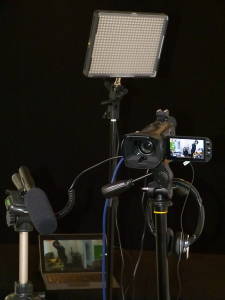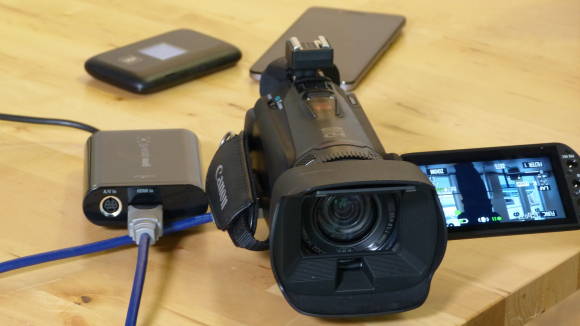 While some might not consider this mobile video streaming kit ‘ultra’ mobile it’s a set of equipment that uses ultra mobile components and can run for up to 3 hours on battery alone. It’s flexible, Full HD capable, can stream to multiple platforms (and RTMP recievers) and includes lighting, a good camera, tripods and the all-important shotgun microphone. This is a set of kit I’ve put together for a new project in Bonn where I will be available to quickly respond to events. There’s an LTE modem (loan from 1und1 Germany) that allows me to connect wherever I am.
While some might not consider this mobile video streaming kit ‘ultra’ mobile it’s a set of equipment that uses ultra mobile components and can run for up to 3 hours on battery alone. It’s flexible, Full HD capable, can stream to multiple platforms (and RTMP recievers) and includes lighting, a good camera, tripods and the all-important shotgun microphone. This is a set of kit I’ve put together for a new project in Bonn where I will be available to quickly respond to events. There’s an LTE modem (loan from 1und1 Germany) that allows me to connect wherever I am.
Video Streaming Equipment list.
The main components in the kit are:
- Surface Pro 3
- Canon Legria HF G25 + remote control
- Elgato Game Capture HD
- LTE router (1und1 Germany)
- Audio Technica ATR 6550 shotgun mic (to about 3 meters from speaker.)
- Aperture Amram H528W LED lamp with battery power and stand
- Tripod with panning head (90)
- Extras including spare mic, mini tripod, SD cards, web camera, PSU for Surface Pro 3
Total cost of the equipment is about 3000 Euro. I will be adding a Panasonic Lumix G7 as a second camera for post processing a multicam edit and for photography. It’s WiFi enabled and should be able to TX direct to the Surface Pro 3 or an Android phablet in order to provide social networking support to events. That Phablet will also give me Periscope ability. Total cost after adding this will be around 4000 Euros.
Elgato Game Capture – Low cost and flexible HDMI capture.
I’ve looked at various hardware solutions for multi-camera live switching but with a starting cost of around 1500 Euro it’s a big investment and, importantly, it’s extremely difficult to find something that will run without mains power. I took a chance with the Elgato Game Capture USB module (150 Euro) and it’s worked out really well so far. The software makes it very easy to connect with YouTube, Twitch or Ustream and it also supports RTMP servers. Streaming rates go up to Full HD 30 FPS and you can even add a webcam and overlays. Using the full features-set requires more CPU than the Surface Pro 3 has but if you’re just streaming a single video stream it uses Intel Quick Sync and runs at about 50% CPU. There are third-party software solutions that allow multicam preview, cross-fading and titling too so I suspect that a Quad Core laptop with a mid-range discreet GPU will be able to handle that for about an hour on battery power.
Backpack-capable video streaming kit.
I can reduce the kit here into a small backpack if I leave out the tripods and spare equipment. Being able to go handheld for an hour or two is a great advantage. I tested it at a local event recently and it worked surprisingly well. I’ll be looking for a way to mount a smartphone together with the Canon so that I can also offer a simultaneous Periscope stream.
Problems streaming over LTE.
Although the 1und1 LTE router supports LTE you can’t rely on any cellular connection when you’re moving around and especially when you’re at an event so streaming rates have to be cut down to below 1Mbps to keep the stream reliable. 480p streaming rates might sound very limited but with good lighting the Canon camera provides a high-quality stabilised feed that can be recorded in full HD for offline editing. Audio quality can also be very good at these rates.
Mobile Streaming equipment walk-through.
You can get an overview of the streaming video equipment in this video.
Tips for better streaming.
I’m running tests on this equipment with the YouTube live streaming platform using the RTMP streaming capability and pre-organised YouTube events. One of the problems I’ve had is that when a stream stops it can give YouTube problems in recreating the stream. I’ve seen audio drop-outs, video without audio and, as was the case yesterday, the stream completely stopped and hasn’t yet been recovered by YouTube as a replay video. I suspect it is because I changed the streaming rates and resolution a short way into the stream so my big tip right now would be to choose a rate that you think you can support and stick with it.
Use fresh batteries and make sure all rechargeable batteries are full before starting.
Regularly monitor the video with headphones to get an idea of source quality. Make sure your camera has an on-screen audio meter. It will give you instant feedback if there’s a problem in the audio chain. I’ve had cases where inserting mains power into the camera has caused hum in the audio and only headphones can capture that.
Check the stream is live by using your phone. Don’t try checking the stream on your streaming device because you’ll affect the network connection speed.
The Elgato Software shows a preview of what’s being streamed. It takes a lot of CPU if you preview a stream with overlays. Keep it turned off as much as you can.
Provide break notifications. You can lose all your viewers if you suddenly go into a break without having any sort of notification. Don’t turn the stream off. An overlay graphic is obviously the best way to do this. Prepare some full HD PNG files beforehand because the Elgato capture software doesn’t have any text creation features.
Investigate XSplit software which can allow multicam scenes with preview (before fade-in.) It will need a high quality laptop with graphics card though. (Think gaming laptop.)
Keep it tight and bright. Make sure you have enough lighting and use all the features of your camera to make sure you have the best source stream. Zoom into subjects but not so far that you’re always having to pan when they move. Use a cameras remote control for hands-off zoom actions (the HF G25 has configurable zoom speeds for the remote control.) Keep the audio as clear as possible. Use an extension cable to get the shotgun mic near the speaker or, if you’re mobile with the mic mounted on the camera, get close to the subject. Start streaming when the event is ready to start and keep viewers informed via lower-thirds titles. You’ll need to prepare these beforehand on the Elgato Software or have a paint program (Paint.net is free and easy) ready to create titles on the fly.
Audience questions pose a problem for audio capture. Ideally you’ll have a second, wireless mic but it’s often not practical to pass it through an audience. A boom mic is better but if you’re in a small room a shotgun mic connected to the mic input of your laptop might be good enough. You can mix this in with the Elgato software. I sometimes mix the camera mics into the audio (a feature on the HF G25 camera) but that can’t be changed when a recording is running.
If you’ve got tips to share, especially if you’re using a mobile rig, please don’t hesitate to share them in the comments section below.












Good stuff Chippy. Which configuration of PRO 3 are u using i7?
Like your setup and use something similar, I changed from the Elagato to a Magewell as Windows then see’s the HDMI source as a direct play device which ensure’s its compatibility with everything.
I’m using Rode wireless lav and handheld mic (newshooter, videomaker kits) to remove more cabling from the setup.